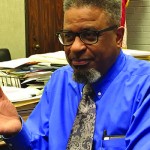Personal reflections of Alonzo W. Ashley (Stanford University Emeritus), the renowned mentor to minority scientists and engineers.
By Al Ashley,
In the Beginning
Born and reared in Tuskegee, Alabama, some of my most unforgettable memories are of interacting with one of the world’s greatest scientists and inventors, Dr. George Washington Carver. Tuskegee is the home of the Tuskegee Institute, now Tuskegee University, and the birthplace of the famous Tuskegee Airmen. Dr. Carver spent more than four decades working, teaching, and inventing at Tuskegee, a historically black university. As the youngest of the four children born to Alonzo Ray and Beatrice Hyde Ashley, I often accompanied my father, a well-learned individual who was very fond of Dr. Carver. Wherever Dr. Carver spoke in the Macon County community, my father always attended the event. I remember him taking me to two of these affairs. Prior to the first event, there were rumors circulating around Tuskegee that Dr. Carver would demonstrate how to make ice cream out of paper. The second event, perhaps the most historic event, was the unveiling of the Booker T. Washington postage stamp on the Tuskegee Institute campus. As I recall, there was a huge crowd because it was Founder’s Day at Tuskegee and Dr. Carver was there.
My elementary school, Chambliss Children’s House, was owned by the Tuskegee Institute and located on the Institute’s campus, three blocks from the George Washington Carver Museum. As students at the school, we made frequent field trips to the Carver Museum where Dr. Carver would show our class around. The scientist was very proud of his flower garden and if we were well behaved, he would show us this treasure. I remember Dr. Carver had a very high-pitched voice. Consequently, many people in the area believed that he had been castrated as a child. However, I later learned that he had diphtheria during his childhood. As children, we often made fun of his voice, but never in his presence or the presence of other adults.
Students attending elementary schools in Macon County received special treats from Dr. Carver. He found out that there was an unusual tree on the property of the Brooks family. Hycall Brooks was in my brother’s class. Dr. Carver arranged a field trip to the Brooks’ home to see the tree that bloomed with flowers once every 100 years. As I recall, Dr. Carver wanted all of the elementary school students to see this tree. He gave my class a brief history and said that we would not see the tree bloom again in our lifetime. As I reflect on my youth in Tuskegee, I realize the highlight of my childhood was being a part of a lecture by one of the most significant scientists in American history.
One of my friends, Arthur Dry, lived directly across from Rockefeller Hall. This was where Dr. Carver lived on campus. Hanging out at my friend’s house gave me the opportunity to see Dr. Carver on many occasions, because he knew the Dry family very well. One day while I was playing with Arthur, Dr. Carver called us over to chat and gave us a quarter (25 cents).
On another occasion, Otis Wright, who lived across the street from my family and was a regular Tenor Soloist on the “Hear the Voice of Dr. G.W. Carver Sunday Morning over WSFA,” took me to see our friend’s twin brothers, Andrew and Augustus Adair appear on “Hear the Voice of Dr. G.W. Carver Sunday Morning over WSFA. After the program, Otis introduced me to Dr. Carver and told him that my nickname was “we-we” Ashley. Dr. Carver laughed and said he would remember that. On several occasions, I saw the scientist strolling across the Tuskegee campus with the auto giant, Henry Ford. I knew that Dr. Carver was an important man. At that point, I did not realize how important and respected he was–professionally and nationally.
Being Healed by the Wizard
It is highly possible that Dr. Carver referred to my brother and I once during his radio program. Based on what I experienced and observed Dr. Carver did amazing things. When I was about six years old, Wendell, who is a few years older, picked me up from school and took me to the Carver Museum. At the time, my brother and I suffered from a mild case of ringworm on our heads. When we arrived at the museum that day, Wendell told me to wait while he looked for Dr. Carver. In introducing me, Wendell said something like, “This is my younger brother, Alonzo. He has these spots on his head and the students at school tease him.” Twisting and turning my head several times, Dr. Carver examined the spots. Then he went into another room. When he returned, he put something on my head. Dr. Carver escorted me to the door and said, “Little boy, you will be all right.” In approximately two days, the ringworm was gone. I had been touched by “The Wizard,” Dr. Carver.
The Fire
In 1947, an unpleasant and unfortunate event occurred: a fire destroyed the George Washington Carver Museum. The morning of the fire, I was delivering the morning newspapers on the Tuskegee Institute campus. My paper route required me to pass the Carver Museum. Because I was always frightened by it, whenever I got near the museum, I always crossed the street. As I neared the museum that morning, I noticed it was on fire. As an eleven-year-old boy, coming upon the fire at 5:30 a.m. was so frightening that I ran away as fast as I could. A few seconds later, a student came by on his bike, saw the building on fire, and began yelling, “Look what they’ve done to Dr. Carver’s Museum!” I was so terrified that I ran, hid in the bushes, and stayed there until the fire truck arrived and a crowd had begun to assemble. To this day, I believe that I was the first person to discover that the Carver Museum was on fire. For the next several weeks, there was considerable talk about the fire being the work of the Ku Klux Klan. Tuskegee Institute officials conducted an investigation, but no one questioned me, and I was too afraid to step forward. I do not recall seeing anyone in the area that morning. To this day, I have not shared this information with my family.
Touching the Lives of Others
Every once in a while, a special person comes along who distinguishes himself above all others as a committed and dedicated public servant. George Washington Carver was such an individual. His devotion to science and to his beloved community is indelible in my mind. In 1968 I was hired at the Stanford Linear Accelerator Center (SLAC) of Stanford University as the Minority Training and Employment Representative. SLAC is a world–renowned laboratory with research opportunities in physics, chemistry, material and environmental science, and allied engineering fields. It is the home of approximately a dozen Nobel laureates in the physical sciences, some of whom I know and have met. They often reminded me of Dr. Carver. However, when I arrived at SLAC, I was pained by the deaths of minority scientists at SLAC and Stanford University. As a result, I wanted to change that picture and nurture more scientists and inventors of color. Interestingly enough, I am not a scientist. I earned a degree in Physical Education and pursued advanced studies in Public Administration. But, since my early childhood in Tuskegee, I have admired students and scholars in sciences and consider myself to be a friend of scientists and students of color.
In 1970, I founded the SLAC Summer Science Program, now called the Department of Energy (DOE) Science Undergraduate Laboratory Internship (SULI) program. This program provides undergraduate minority students with an interest in science, technology, engineering, and mathematics (STEM) summer research experiences at DOE laboratories. Although retired from Stanford University, I continue to be influenced by Dr. Carver. My life focus continues to be this: to touch the lives of others by providing opportunities for undergraduate students in STEM. In 2004, I founded the Arkansas Mentoring and Networking Association (AMNA), a non-profit corporation to promote opportunities for historically underrepresented students in STEM. The purpose of AMNA is to educate students about the art of networking, to emphasize the importance of securing mentor relationships as a natural part of their academic experience, and to inform students about summer internships and research opportunities.
Feeling Forever Grateful
My opportunity to meet, see, and speak with Dr. George Washington Carver was not just unique to me. A great many of the children, who lived in Tuskegee and Macon County saw, talked to, and met with Dr. Carver more times than I could imagine. During his lifetime, Dr. Carver received many honors. On January 5, 1948, he was honored on the three-cent stamp and again in 1951 when the Booker T. Washington/George Washington Carver memorial half dollars were issued until being discontinued in 1954. I believe that racial segregation, discrimination, and Jim Crow prevented him from receiving other high honors, such as the Nobel Prize in Chemistry. Dr. George Washington Carver is my all-time hero, and I am blessed to have had the opportunity to meet him during my youth, a privilege that few youth experienced, regardless of race.
Alonzo (Al) Ashley
Staff Emeritus Stanford University
About the author – Alonzo (Al) Ashley retired from the Stanford Linear Accelerator Center in 1999 after 31 years of dedicated and exemplary service, particularly in the area of championing diversity in the sciences and engineering. During his tenure at SLAC, Ashley pioneered programs that promoted diversity and encouraged career development for employees, and career exploration for talented students. He was a recipient of a 2005 National Science Foundation Presidential Award for Excellence in Science, Mathematics and Engineering Mentoring in recognition of his outstanding mentoring efforts and programs that enhanced the participation of historically underrepresented groups in science, mathematics, and engineering. Ashley served as a mentor to hundreds of emerging scientists and engineers during their journey to their chosen field.











